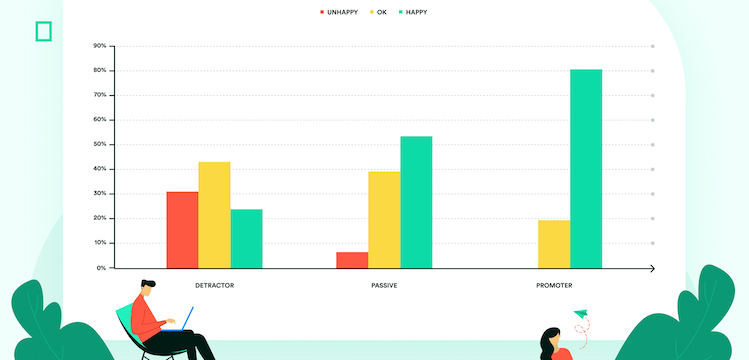
Could you be happier at work?
Take our quiz and find out! It takes just five minutes and you'll get a data-packed report afterwards.
The fundamental flaws of eNPS & why Happiness is the answer
As organizations look to grow and develop, measuring employee wellbeing has become essential. Some may choose the eNPS (employee Net Promoter Score) to gauge satisfaction, yet this metric is limited. While eNPS offers a glimpse into how people are feeling, it’s not the best indicator for wellbeing. Happiness is far more effective in tracking and building a healthy, engaged workplace.

eNPS, adapted from the Net Promoter Score, categorizes responses into promoters (scores of 9-10), detractors (0-6), and passives (7-8). This score, calculated by subtracting detractors from promoters, attempts to provide a simple, single number to indicate employee sentiment.
Organizations often use it to track trends over time, hoping that a rising score reflects greater employee satisfaction and engagement.
However, while eNPS is easy to calculate, it has significant limitations that prevent it from being a true reflection of employee experience.
The limitations of eNPS
While useful as a quick gauge of sentiment, eNPS falls short in several ways:
- Focuses on advocacy, not experience. The eNPS question, “How likely are you to recommend [Organization] as a place to work?” is geared towards measuring brand loyalty rather than individual wellbeing. This question doesn’t provide insights into the employee’s day-to-day experience or what would improve their work life. Instead it can feel extractive - another thing that the company will ask the employee to do, a chore for the employee.
- Hypothetical and not time-bound. Asking employees to predict how they might advocate for their organization doesn’t address their current feelings or daily realities. Because it lacks a specific time frame, responses may vary widely depending on context, which limits its usefulness for regular, actionable insights.
- Oversimplifies employee sentiment. With detractors, passives, and promoters as the only response groups, eNPS reduces employee sentiment to a broad and vague scale. For example, an employee scoring a “6” and one scoring a “0” both count as detractors, though their reasons may differ significantly. This lack of nuance limits the accuracy of the insights it provides.
- Ignores dynamic experiences. Employee experience isn’t static and fluctuates based on many factors. With eNPS typically measured quarterly, it risks missing critical changes and trends within a team’s engagement, making it less effective than happiness for understanding ongoing challenges and progress.
Why measuring Happiness is a better solution
Workplace experience resembles a constantly moving “stock price,” with regular ups and downs. A less frequent eNPS captures only a single point, much like viewing a stock price every so often. Happiness, measured weekly or monthly, is a more responsive indicator that reflects actual workplace sentiment in real time.
By asking employees how they feel each week or month, Happiness tracks dynamic experiences. Weekly or monthly insights provide leaders with actionable information on team morale, allowing for timely responses that support long-term wellbeing. It also signals to employees that their daily experiences matter, fostering a collaborative relationship where feedback translates into positive change.
The predictive power of happiness
While eNPS captures an employee’s willingness to recommend their workplace, it doesn’t capture happiness directly. However, happy employees are naturally more likely to act as advocates. The data shows that employees with high happiness scores are often promoters, highlighting the predictive power of happiness for eNPS.
eNPS vs. Employee Happiness

The graph confirms things that you may have already concluded as ‘common sense’. Happy employees are much more likely to be promoters, and unhappy employees are much more likely to be detractors.
Tracking happiness is a more accurate way to understand employees' advocacy and engagement levels. It also links to other key business outcomes, such as:
- Higher retention – Unhappy employees are twice as likely to leave.
- Productivity boost – Happier teams are 28% more productive.
- Innovation – Happy employees are three times more creative and collaborative.
For many organizations, measuring happiness has also been beneficial in attracting talent. Sharing Friday Pulse results in recruitment communications can help employers demonstrate a commitment to wellbeing, attracting more qualified candidates who prioritize supportive work environments.
How Friday Pulse can help
At Friday Pulse, we believe that happiness is the best metric for capturing true employee experience. And happiness data is far more versatile. It provides leaders with timely, nuanced insights and fosters a culture that values employee wellbeing as much as performance.
For a more effective way to understand and support your employees, consider exploring Friday Pulse. You can book a demo to see how Friday Pulse can transform your organization.